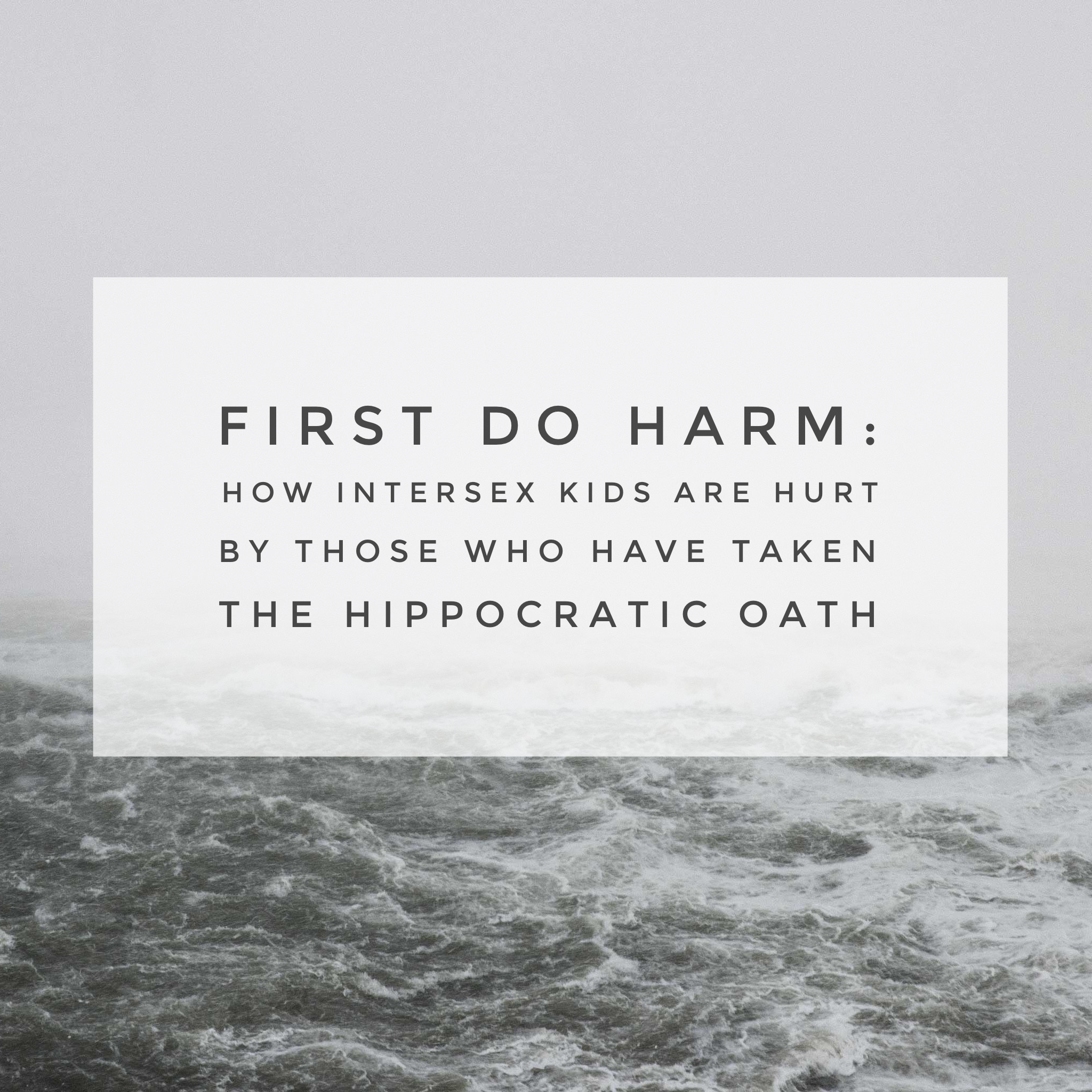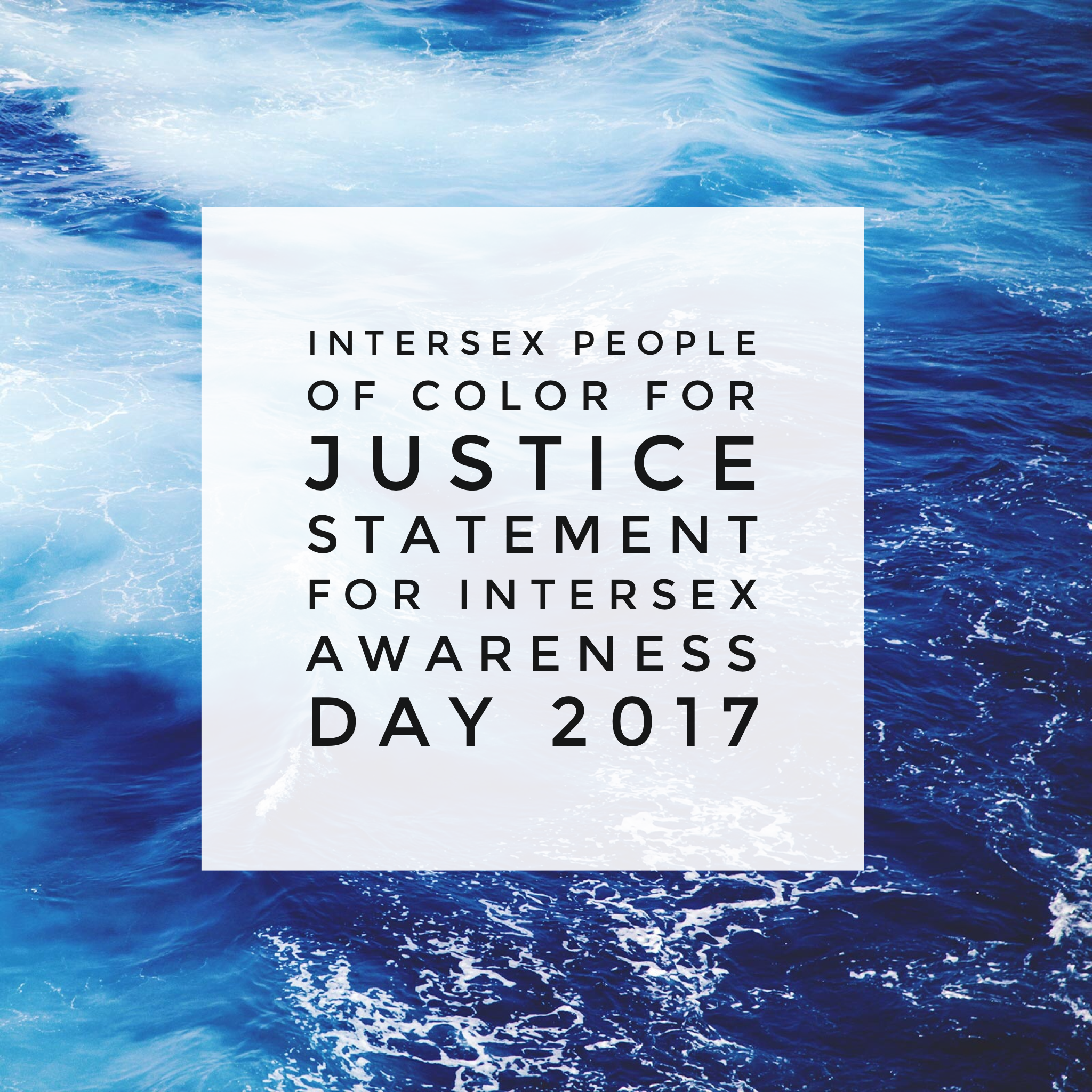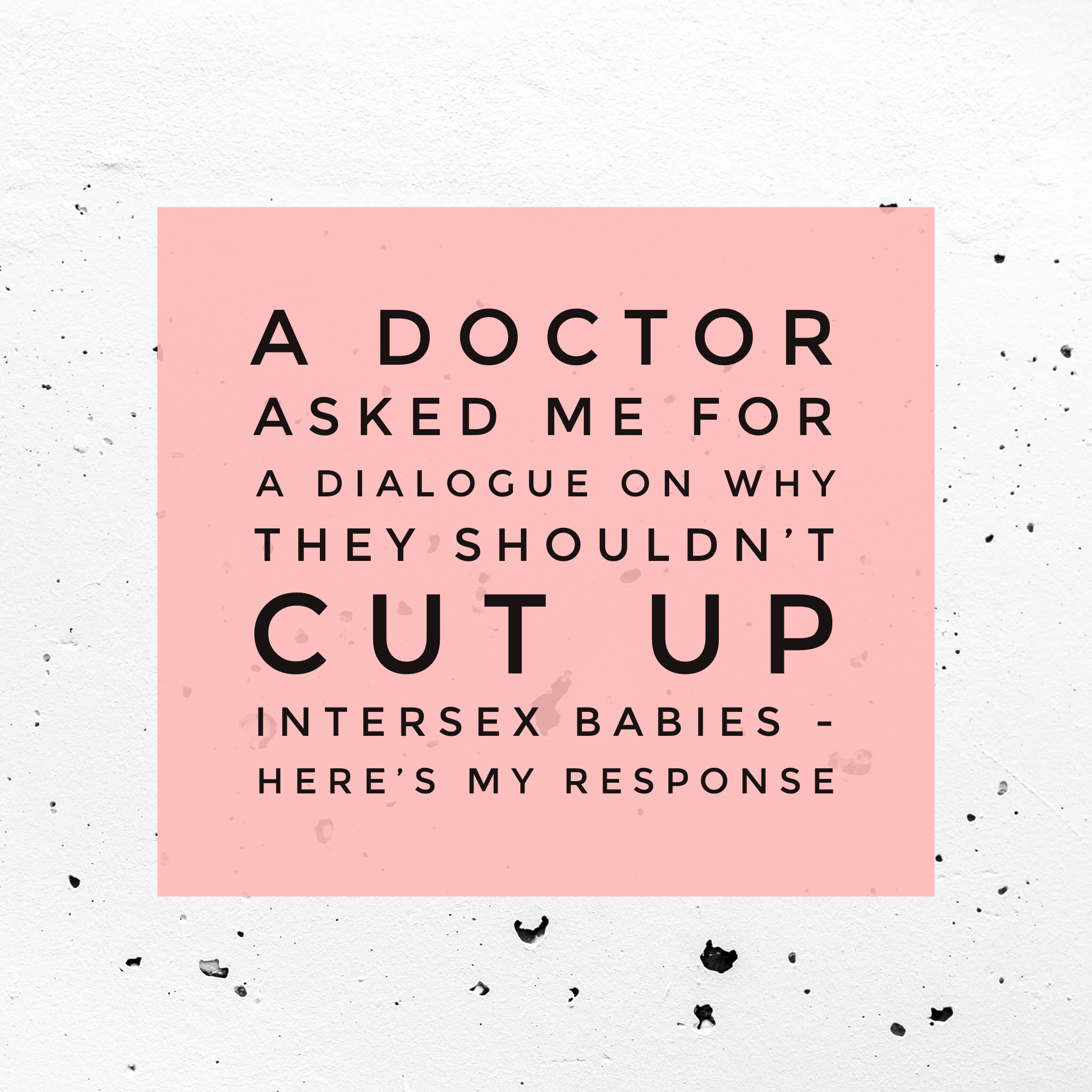First Do Harm: How Intersex Kids Are Hurt by those Who Have Taken the Hippocratic Oath
Hippocrates, the so-called father of Western medicine presumably wrote the Hippocratic Oath at some point between the third and fifth century BCE. The phrase “first, do no harm,” synonymous with the oath, actually doesn’t appear in the original, or in today’s modern version. Yet, similar principles are strewn throughout the modern version that doctors, entrusted with my care as a young intersex child, neglected to honor.
Unfortunately, as I discovered the hard way, the oath doesn’t seem to apply to roughly 2% of the population born with sex characteristics that fall outside typical male or female parameters—also referred to as intersex.
Instead, doctors dealing with intersex kids discard tenets of the oath and instead abide by an outdated protocol grounded in secrecy, shame and surgery. I call this model the concealed non-consensual surgery (CNCS) model. This model is what I grew up with, and will be the basis for the rest of this essay which compares parts of today’s version of the Hippocratic Oath with relevant parts about my experience growing up intersex in the US.
I. I will apply, for the benefit of the sick, all measures which are required, avoiding those twin traps of over-treatment and therapeutic nihilism.
If gender was a football field, I was born at the 50-yard-line between male and female goal posts. At birth, my body was told by its coach—my 46 XY chromosome pair with it’s inactive SRY gene—to run the “Trojan horse” play. And so, my body was born ripe with intersex intricacies that weren’t immediately apparent at my birth.
Believing the Trojan horse to be a mare, clinicians typed F on my birth certificate and sent my parents home with their first child, a baby girl.
Six months later, the defense read my coach’s play and my pediatrician spotted something peculiar between my legs. Soon after, I was stripped naked before pediatric specialists at the local Children’s hospital in Chicago, and my hidden intersex soldiers’ offensive play was foiled.
Confronted by diagnostic test after test, the defense discovered my karyotype results were indeed XY, not XX, like everyone assumed.
II. I will remember that there is art to medicine as well as science, and that warmth, sympathy, and understanding may outweigh the surgeon's knife or the chemist's drug.
As a child, I had a disturbing recurring dream. In it, I’d wake up flat on a gurney whizzing down a hospital hallway. One after another, rectangular fluorescent lights became a single long beam. Bending my chin towards my chest, I’d always be shocked awake by what I saw.
Packed amidst my thighs, between my vagina and kneecaps, were what I could only describe as rolls of blood soaked toilet paper.
I never told anyone about the nightmare, and just thought of it as one of my many weird recurring dreams. Eventually, I stopped having it, grew up, and moved away to college.
At school, I had other things to worry about, like starting over with new people in a new place. In junior high and high school, I struggled to keep up with the constant maintenance work of trying to appear normal.
During bi-annual check-ups, my doctors stressed—as they palpated my breasts and peered between my legs—that I not only was, but more importantly, looked normal. In spite of this, I never felt quite normal.
Maybe it was because I knew other kids didn’t have these types of checkups. Or, maybe it was because my family told me at young age that I wouldn’t get a period or be able to give birth to children because I was born with cancer in my ovaries.
This scripted version of the truth, an offensive play the doctors told my family to run on me, made me believe that my doctors saved my life. When I appeared sad, my family always reminded me that I could always adopt.
But all of that reassurance didn’t matter once the other girls in school began to go through puberty and get their periods. Everyone insisting I was normal didn’t change the reality that every time I looked past my flat chest, towards my pristine underwear, my lack of a menses reminded me I was indeed different.
As the doctors lied to my parents, and my parents lied to me, I began to lie to my peers.
By the time I finished junior high, I couldn’t keep track of all the different scenarios in which I had gotten my first period. By the time I graduated high school, I couldn’t count how many times I pretended to have my period—even going as far as painfully inserting tampons—in order quell any suspicion my boyfriend may or may not have had.
Always pretending to be something I wasn’t was draining. I constantly worried that those around me had begun to figure out what I was hiding inside of my Trojan horse. I hoped college would be a reset; a new, freer me.
Yet, once I moved to college, I doubled down and worked even harder to keep up the appearance of the normal happy girl. I diligently kept tampons on hand for others and hid my hormone replacement therapy medication.
The facade came crashing down the day I retrieved my medical records from my children’s hospital, whose front doors were just down the street from my college dorm-room.
Reading the pages of my medical records, which began in 1986, turned me into a red-hot sobbing puddle in the middle of a tiny cinderblock dorm study room.
What I read in those records transformed the way I saw my doctors who before were trustworthy life savers. Afterwards, they seemed like people who got away with violating my human rights.
III. I will not be ashamed to say “I know not,” nor will I fail to call in my colleagues when the skills of another are needed for a patient's recovery.
My medical records illuminate not only how my physicians fell for the trap of over-treatment, but also that they weren’t ever humble enough to admit they didn’t have all the answers. They failed to call in colleagues, such as therapists, who were actually necessary and could have been helpful as I grew and developed a sense of my intersex identity, and figured out its place in this binary world.
In the introduction to Herculine Barbin: Being the Recently Discovered Memoirs of a Nineteenth-Century French Hermaphrodite, Foucault argues that the objective of social institutions is to restrict “the free choice of indeterminate individuals”. My doctors exemplified Foucault’s claim when they decided, with no input from myself, to surgically assign my sex-uncertain body to appear phenotypically female.
It must have seemed like a no-brainer for my parents when my doctors presented them with surgical fixes for their kid. The clinicians told them that I was born with underdeveloped ovaries—which they referred to as gonads but in actuality were undescended testes—that would most likely become cancerous if left intact.
While there is a valid cancer concern in cases of intersex, it’s not as dire as some providers make it seem. A 2013 Australian Senate Inquiry Report on Involuntary or Coerced Sterilisation of Intersex People in Australia cites the risk of gonadal malignancy for CAIS and PAIS to be .8 per cent and 15 per cent respectively, and concluded a “serious shortage of quality information” when it came to truly understanding this risk.
Regardless, I agree with the Organization Intersex International - Australia, who points out that since the likelihood of cancer occurring in undescended testes before puberty is extremely low, maintaining one’s testes should be an intersex person’s choice.
Surgeons don’t routinely remove people’s prostates after birth because they have a likelihood of developing cancer later in life. Instead, people are allowed to have bodily autonomy, and clinicians may monitor for cancer down the line. This shouldn’t be any different for intersex people who are born with undescended testes.
Removing our healthy testes, and other reproductive organs, before we are of an age to give fully informed consent, is an affront to our human rights.
My medical records contain lengthy descriptions of consultations, evaluations, diagnostics, blood work, biopsies, and surgeries; a one-sided synopsis bereft of the one person’s voice whose humanity was actually affected by these decisions. Above all, they provide an account of a miscommunication between my healthy intersex body and the binary world it threatened, and the covert operation undertaken to de-escalate it.
IV. “Most especially must I tread with care in matters of life and death. Above all, I must not play at God.”
Learning about the orchiectomy, the procedure in which my testes were removed before I was 1-year-old, paled in comparison to what I read next.
On October 27, 1990, when I was four-years-old, I was admitted to the children’s hospital again. Five days later, I was discharged without my clitoris due to “a clitoral resection and recession.” In other words, I was given a clitorectomy because the doctors felt my clitoris—a mere centimeter and a half “when stretched”—wasn’t something a girl should have.
This “state sponsored violence” is still happening today as evidenced by the recent Australian family court case involving a young child named Carla who was sterilized and given a clitorectomy.
It was that unnecessary, and purely “cosmetic," genital mutilating surgery in 1990 that prompted the reoccurring dream I had as a child of blood soaked toilet paper between my legs. It wasn’t just a bad a dream, but a chilling memory of being over-treated by clinicians who were too stubborn to say ‘I don’t know’.
I also found out that when I was 11, and admitted for what I was told was a bladder surgery, I actually underwent a non-consensual vaginoplasty. My “excellent results," the records boast, would allow for “normal adult relationships.” Normal sex, was of course, defined by my surgeons.
As stated earlier, intersex isn’t that rare and intersex variations show up somewhere between .05 per cent and 1.7 per cent of the human population. The higher end of the range is similar to the amount of natural born redheads. Since we’re not rare—just invisible—it means what happened to me is unfortunately not rare either.
The majority of intersex people are not born with any related life-threatening health issues. Yet, doctors consistently pressure parents to act, not to save our lives, but to save our outdated and fragile binary understanding of sex and gender. Instead of stating ‘I don’t know,’ and waiting to ask intersex children what they want for themselves when they grow up, our doctors instead play God.
Doctors who deal with intersex kids are quick to tell you today that things are changing for the better. Yet, there is no mandate for hospitals to report the types, or amounts, of surgeries they are performing on intersex kids.
If you do hear them make this claim, make them be more specific like my colleague Anne Tamar-Mattis does, by asking them which intersex kids who would have been candidates for surgery 20 years ago, they wouldn’t consider as candidates today.
If they boast that they now refer intersex patients to psychologists, ask them who those psychologists are, and what percentage of referrals actually follow through long-term.
If they tell you that most of their intersex patients are happy with their treatment, ask them how many they have followed into adulthood, and how they know they are happy with what their doctors did.
If you’re feel particularly brave and want to address the elephant in the room, ask why they are even doing any medically unnecessary surgery on intersex children at all.
It’s been over 10 years since I first retrieved my medical records. Since then, I’ve been able to lead a training, in which a youth member of InterACT and I gave an anti-surgery intersex presentation to team members of a clinic who work with intersex children at my former children’s hospital.
In a subsequent meeting, the clinic’s lead pediatric urology surgeon, Dr. Earl Cheng, expressed that he wanted to be the person in his field to do better by intersex patients. At that point, my colleague Anne Tamar-Mattis who was also present for that meeting asked, “If so, are you willing to be accountable for the harm your profession has caused intersex people?”
He replied, “No, I’m not.”
This is the familiar wall intersex people and activists consistently find ourselves up against. We have yet to reach a pivotal point where doctors are willing to stop playing God, and instead, let intersex people decide how we would like to live our destinies.
If we are to move forward, we need the medical profession—which has caused so much harm to our community—to hold themselves accountable to the Hippocratic Oath.
While I don’t have the power to control what happened to me in the past, I can make every effort to change the future for intersex children.
It is my hope, in this future, that we move away from the CNCS model that’s been the hallmark of intersex treatment since the 1950s, and completely end these medically unnecessary damaging surgeries. Accountability from the medical community is imperative if we are to close this dark chapter and move forward.
In this new phase, when an intersex child is born we only need doctors to inform parents that they have a happy, healthy intersex child who is “perfect just the way they are,” as the UN campaign launched on Intersex Awareness Day 2016 advises.
The campaign also points out that in most countries, there’s no legal reason to rush to assign and register a sex. Regardless of when, parents should only do so with the idea that it’s not permanent, and that an intersex child should be allowed to grow up and declare their sex and gender when they are old enough to do so.
Most importantly, genital mutilating surgeries needs to be a thing of the past in this new chapter. As the UN reminds us:
There is no evidence that cosmetic surgery and treatment help your intersex child. Parents pressured into agreeing to such practices have often reported having regrets because it did not benefit their child, harmed them, and created difficulties in the parent-child relationship. The risks of these procedures are serious: permanent infertility, pain, incontinence, loss of sexual sensation, and lifelong mental suffering.
Instead, every effort should be made to connect parents with well-regarded therapists and intersex support groups such as AIS-DSD Support Group.
As we flip the pages into this next chapter, we should focus on changing society, not healthy intersex bodies just because they don’t fit our limited views of sex and gender.
In addition, medical institutions that have robbed intersex people of our bodily autonomy need to formally apologize, and work with intersex activists to declare new intersex-affirming standards of care. Lastly, these same institutions need to contribute to a reparations fund that guarantees all current and future intersex people free medication, services and therapy.
This new chapter is already being written, and you just have to type intersex into a search engine to see it. Every day, there are brand new activist projects and resources popping up all over the world. Intersex people across the globe are doing the necessary work to build this brighter future for our children, and yours, by lifting up our stories.
In speaking our truths, we are collectively ridding the world of the stigma that is at the root of the outdated CNCS model. This devastating clinical model has unjustly dominated medicine’s response to our bodies since the 1950s, and it’s long past time that it disappears.
Instead of critiquing bodies, a critique of the antiquated binary sex and gender categories is what’s needed. Intersex people, like all unnecessarily stigmatized people, don’t need to be fixed—instead society needs fixing. Luckily, this chapter can begin right now with parents of newborn intersex children doing what they’re already instinctively programmed to do: love and protect their intersex child.
Reference List
Articles/Books/Reports
Barbin, Herculine, Michel Foucault (ed) and Richard McDougall (trans), Herculine Barbin: being the recently discovered memoirs of a nineteenth century French hermaphrodite (Harvester Press, 1980)
Blackless, M et al, ‘How sexually dimorphic are we? Review and synthesis’ (2000) 12(2) American Journal of Human Biology 151
B Cases
Re: Carla (Medical procedure) [2016] FamCA 7
C Other
AIS-DSD Support Group, Home (2017) <http://aisdsd.org/>
AIS Support Group Australia, Peer Support, Information and Advocacy for Intersex People and their Families (10 March 2017) <http://www.aissga.org.au/>
AsapSCIENCE, We were all female (10 January 2013) YouTube <https://www.youtube.com/watch?v=z1Kdoja3hlk>
InterACT, Our Advocacy (2016) <http://interactadvocates.org/our-advocacy/intersex-youth/>
Morgan, The Family Court case Re: Carla (Medical procedure) [2016] FamCA 7 (8 December 2016) <https://oii.org.au/31036/re-carla-family-court/>
Office of the United Nations High Commissioner for Human Rights, A step forward for intersex visibility and human rights (25 September 2015) <http://www.ohchr.org/EN/NewsEvents/Pages/Astepforwardforintersexvisibility.asp>
Office of the United Nations High Commissioner for Human Rights, Fact sheet: Intersex (2015) <https://unfe.org/system/unfe-65-Intersex_Factsheet_ENGLISH.pdf>
Senate Community Affairs References Committee, Parliament of Australia, Involuntary or coerced sterilisation of intersex people in Australia (2013) 86
Tamar-Mattis, Anne, Anne Tamar-Mattis – Publications (2017) ResearchGate <https://www.researchgate.net/profile/Anne_Tamar-Mattis/publications>
UN Free & Equal, Intersex Awareness (2016) <https://www.unfe.org/intersex- awareness/>




